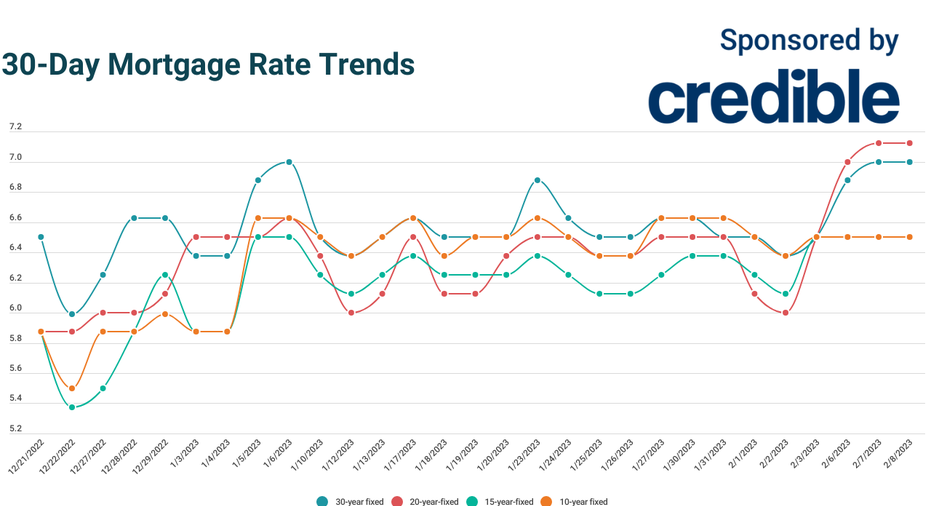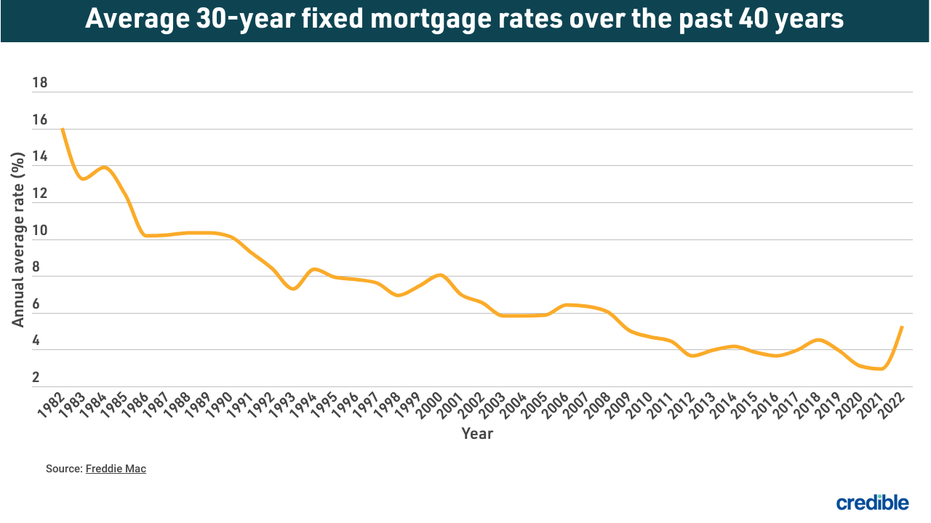Still time to save: Today's mortgage rates rest across all terms | Feb. 8, 2023
With rates holding steady across all repayment terms, buyers may want to lock in a rate today ahead of likely fluctuations

Check out the mortgage rates for Feb. 8, 2023, which are unchanged from yesterday. (Credible)
Based on data compiled by Credible, mortgage rates for home purchases remained unchanged across all terms since yesterday.
- 30-year fixed mortgage rates: 7.000%, unchanged
- 20-year fixed mortgage rates: 7.125%, unchanged
- 15-year fixed mortgage rates: 6.500%, unchanged
- 10-year fixed mortgage rates: 6.500%, unchanged
Rates last updated on Feb. 8, 2023. These rates are based on the assumptions shown here. Actual rates may vary. Credible, a personal finance marketplace, has 5,000+ Trustpilot reviews with an average star rating of 4.7 (out of a possible 5.0).
What this means: Mortgage rates rested across all key terms today, but rates for 30- and 20-year terms remain at or above 7%. Borrowers who can manage a higher monthly payment will find greater interest savings with 15- and 10-year terms. Buyers may want to take advantage of this pause and lock in a rate ahead of future increases.
To find great mortgage rates, start by using Credible’s secured website, which can show you current mortgage rates from multiple lenders without affecting your credit score. You can also use Credible’s mortgage calculator to estimate your monthly mortgage payments.
Based on data compiled by Credible, mortgage refinance rates are mixed today, with one key rate falling, one rising and two others holding steady since yesterday.
- 30-year fixed-rate refinance: 6.875%, unchanged
- 20-year fixed-rate refinance: 7.000%, down from 7.125%, -0.125
- 15-year fixed-rate refinance: 6.500%, unchanged
- 10-year fixed-rate refinance: 5.125%, up from 4.750%, +0.375
Rates last updated on Feb. 8, 2023. These rates are based on the assumptions shown here. Actual rates may vary. With 5,000 reviews, Credible maintains an "excellent" Trustpilot score.
What this means: Although 30-year mortgage refinance rates held steady at 6.875% since yesterday, homeowners who can swing a larger monthly payment may do well to consider 10-year rates, which are the lowest available at 5.125%. Homeowners who want to make home improvements can save more on interest with a cash-out refinance than they would by funding those improvements with credit cards or personal loans.
How mortgage rates have changed over time
Today’s mortgage interest rates are well below the highest annual average rate recorded by Freddie Mac — 16.63% in 1981. A year before the COVID-19 pandemic upended economies across the world, the average interest rate for a 30-year fixed-rate mortgage for 2019 was 3.94%. The average rate for 2021 was 2.96%, the lowest annual average in 30 years.
The historic drop in interest rates means homeowners who have mortgages from 2019 and older could potentially realize significant interest savings by refinancing with one of today’s lower interest rates. When considering a mortgage refinance or purchase, it’s important to take into account closing costs such as appraisal, application, origination and attorney’s fees. These factors, in addition to the interest rate and loan amount, all contribute to the cost of a mortgage.

How Credible mortgage rates are calculated
Changing economic conditions, central bank policy decisions, investor sentiment and other factors influence the movement of mortgage rates. Credible average mortgage rates and mortgage refinance rates reported in this article are calculated based on information provided by partner lenders who pay compensation to Credible.
The rates assume a borrower has a 740 credit score and is borrowing a conventional loan for a single-family home that will be their primary residence. The rates also assume no (or very low) discount points and a down payment of 20%.
Credible mortgage rates reported here will only give you an idea of current average rates. The rate you actually receive can vary based on a number of factors.
Factors that influence mortgage rates (and are out of your control)
Many factors influence the interest rate a lender may offer you. Some — such as your credit score — are in your control. But others you have no ability to affect, such as:
- The economy — During financial downturns, the Fed may lower interest rates to try to stimulate the economy. And when the economy is doing well, interest rates can rise.
- Inflation — Interest rates tend to move with inflation. When the overall cost of goods and services increases, interest rates are also likely to rise.
- The Federal Reserve — The Fed may choose to lower interest rates to stimulate a struggling economy, or raise rates in an attempt to put the brakes on inflation.
- Macro employment trends — When many people are out of work, as they were during the months of pandemic lockdown, mortgage rates may fall. As employment increases, interest rates typically also increase.
If you’re trying to find the right mortgage rate, consider using Credible. You can use Credible's free online tool to easily compare multiple lenders and see prequalified rates in just a few minutes.
Have a finance-related question, but don't know who to ask? Email The Credible Money Expert at moneyexpert@credible.com and your question might be answered by Credible in our Money Expert column.




















